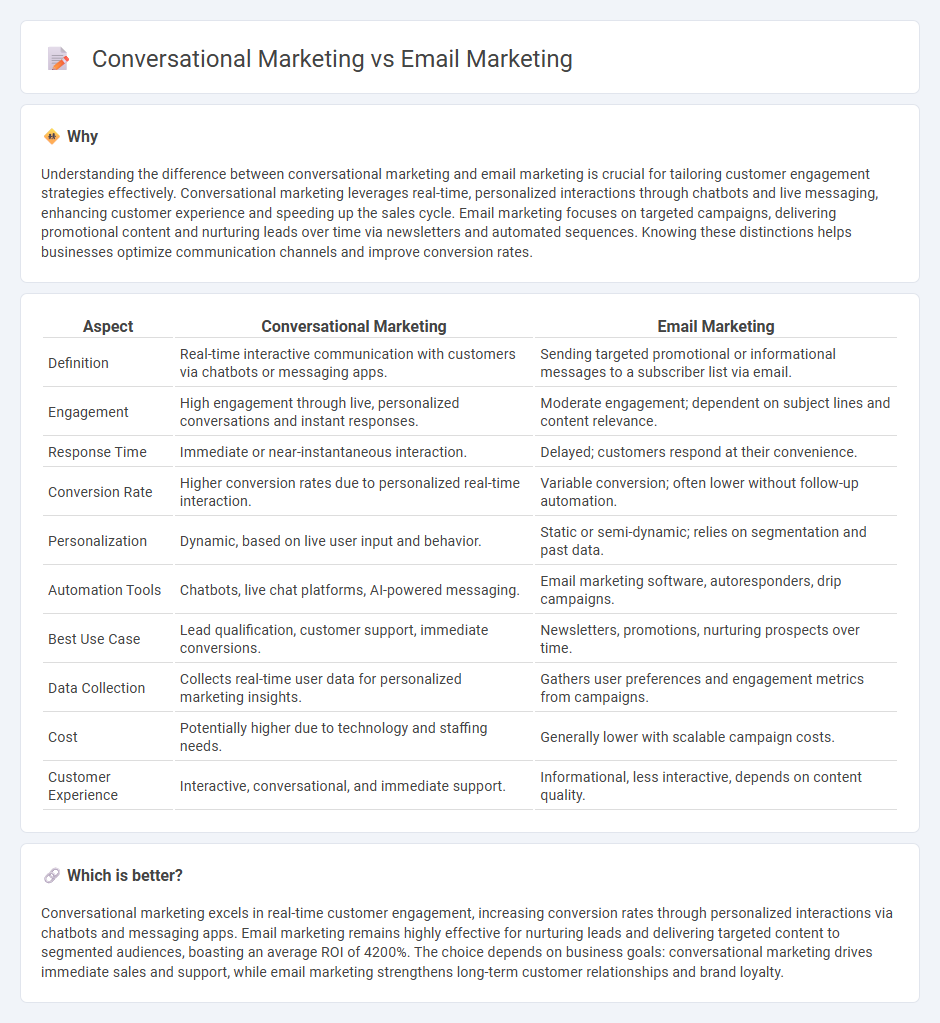
Conversational marketing fosters real-time, personalized interactions through live chat, messaging apps, and chatbots, enhancing customer engagement and immediate feedback. Email marketing focuses on targeted campaigns via newsletters and promotions to nurture leads and build long-term customer relationships through automated sequences. Explore how combining both strategies can maximize your marketing effectiveness.
Why it is important
Understanding the difference between conversational marketing and email marketing is crucial for tailoring customer engagement strategies effectively. Conversational marketing leverages real-time, personalized interactions through chatbots and live messaging, enhancing customer experience and speeding up the sales cycle. Email marketing focuses on targeted campaigns, delivering promotional content and nurturing leads over time via newsletters and automated sequences. Knowing these distinctions helps businesses optimize communication channels and improve conversion rates.
Comparison Table
| Aspect | Conversational Marketing | Email Marketing |
|---|---|---|
| Definition | Real-time interactive communication with customers via chatbots or messaging apps. | Sending targeted promotional or informational messages to a subscriber list via email. |
| Engagement | High engagement through live, personalized conversations and instant responses. | Moderate engagement; dependent on subject lines and content relevance. |
| Response Time | Immediate or near-instantaneous interaction. | Delayed; customers respond at their convenience. |
| Conversion Rate | Higher conversion rates due to personalized real-time interaction. | Variable conversion; often lower without follow-up automation. |
| Personalization | Dynamic, based on live user input and behavior. | Static or semi-dynamic; relies on segmentation and past data. |
| Automation Tools | Chatbots, live chat platforms, AI-powered messaging. | Email marketing software, autoresponders, drip campaigns. |
| Best Use Case | Lead qualification, customer support, immediate conversions. | Newsletters, promotions, nurturing prospects over time. |
| Data Collection | Collects real-time user data for personalized marketing insights. | Gathers user preferences and engagement metrics from campaigns. |
| Cost | Potentially higher due to technology and staffing needs. | Generally lower with scalable campaign costs. |
| Customer Experience | Interactive, conversational, and immediate support. | Informational, less interactive, depends on content quality. |
Which is better?
Conversational marketing excels in real-time customer engagement, increasing conversion rates through personalized interactions via chatbots and messaging apps. Email marketing remains highly effective for nurturing leads and delivering targeted content to segmented audiences, boasting an average ROI of 4200%. The choice depends on business goals: conversational marketing drives immediate sales and support, while email marketing strengthens long-term customer relationships and brand loyalty.
Connection
Conversational marketing leverages real-time, personalized interactions through chatbots and messaging platforms to engage customers, while email marketing delivers targeted content directly to their inboxes. Both strategies use customer data and behavior insights to create tailored communication that fosters engagement and drives conversions. Integrating conversational marketing with email campaigns enhances lead nurturing by combining immediate dialogue with follow-up messaging, optimizing the overall customer journey.
Key Terms
Personalization
Email marketing leverages segmentation and targeted content to deliver personalized messages that increase engagement and conversion rates. Conversational marketing utilizes real-time interactions through chatbots and messaging apps to tailor experiences based on user responses and preferences. Explore how integrating these strategies can maximize customer personalization and drive business growth.
Automation
Email marketing leverages automation to deliver personalized content at scale, using triggered emails and drip campaigns to nurture leads over time, which increases engagement rates and conversion potential. Conversational marketing employs automated chatbots and real-time messaging to create interactive, personalized experiences that immediately address customer inquiries and guide them through the sales funnel. Explore how integrating these automation strategies can enhance your customer engagement and accelerate sales cycles.
Engagement
Email marketing leverages personalized campaigns to nurture leads and drive conversions through targeted content and automated workflows, enhancing customer engagement over time. Conversational marketing employs real-time interactions via chatbots and live messaging to create immediate, personalized customer experiences that boost engagement and accelerate the sales funnel. Discover how integrating these strategies can optimize your customer interaction and maximize engagement.
Source and External Links
What is Email Marketing? [An Expert Guide for Beginners] - Email marketing is a digital marketing method using email to attract and engage customers, relying on an email list, an email service provider, and clear campaign goals to be effective.
Email marketing -- a step-by-step guide to getting started - This guide outlines steps such as defining your audience, setting goals, building and segmenting an email list, creating and testing emails, and measuring results, highlighting the importance of compliance and using platforms like Adobe Campaign to streamline the process.
What Is Email Marketing? - Coursera - Email marketing is a strategy to connect with customers, build loyalty, and promote products by sending personalized emails like welcome messages, newsletters, promotional offers, and transactional notifications.
 dowidth.com
dowidth.com